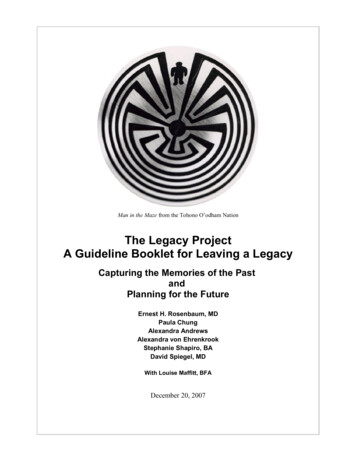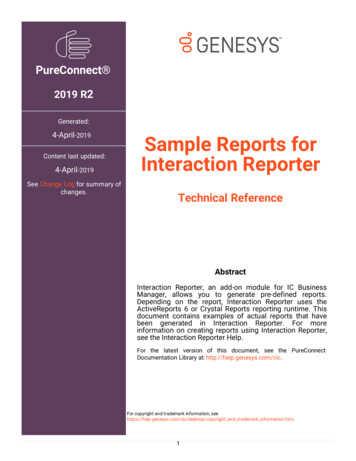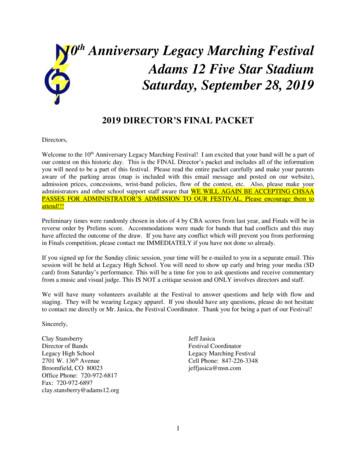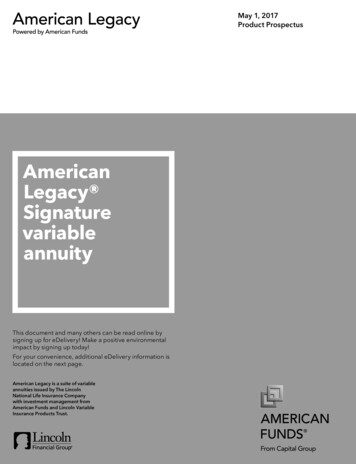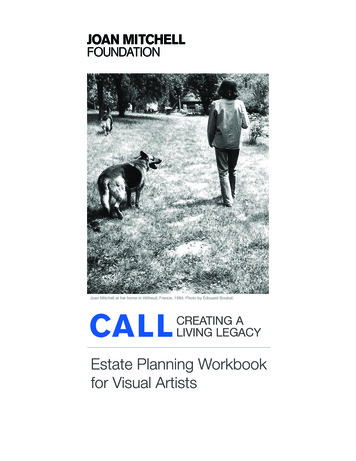
Transcription
Joan Mitchell at her home in Vétheuil, France, 1984. Photo by Édouard Boubat.CREATING ALIVING LEGACY
CALLCREATING A LIVING LEGACYEstate Planning Workbookfor Visual ArtistsContentsAcknowledgments . . . . . . . . . . . . . . . . . . . . . . . . . . . . . 2Introduction . . . . . . . . . . . . . . . . . . . . . . . . . . . . . . . . 7Your Legacy . . . . . . . . . . . . . . . . . . . . . . . . . . . . . . . . 8Legacy Vehicles . . . . . . . . . . . . . . . . . . . . . . . . . . . . . 13The Basics . . . . . . . . . . . . . . . . . . . . . . . . . . . . . . . . 16Your Team . . . . . . . . . . . . . . . . . . . . . . . . . . . . . . . . 19Your Estate . . . . . . . . . . . . . . . . . . . . . . . . . . . . . . . . 21Estate Planning Questions for the Artist . . . . . . . . . . . . . . . . . 26Estate Planning Questions for the Artist on Copyright . . . . . . . . . . 32Talking With an Estate Planning Attorney . . . . . . . . . . . . . . . . 33Other Resources . . . . . . . . . . . . . . . . . . . . . . . . . . . . . 34Workbook Contributors . . . . . . . . . . . . . . . . . . . . . . . . . 35This resource was originally published in 2012,and reprinted in 2019 with minor revisions. 1
CALLCREATING A LIVING LEGACYAcknowledgmentsSPECIAL THANKSThe Joan Mitchell Foundation would like to acknowledge andthank our Board of Directors for their invaluable support andcontributions to the development of the Creating a LivingLegacy Estate Planning Workbook.Joan Mitchell Foundation Board of Directors»» Alejandro Anreus, Ph.D., President»» Tomie Arai, Vice-President»» Theodore S. Berger, Treasurer»» Ronald Bechet»» Dan Bergman»» Tyrone Mitchell»» Yolanda Shashaty»» Michele Tortorelli»» John Koos (Emeritus)Special thanks to Carolyn Somers for her vision andcommitment to preserving the cultural legacies of visualartists, and to Paul Mpagi Sepuya and Christa Blatchfordfor their dynamic and adaptive management of the CALLProgram. The Arts & Business Council of Greater Boston/VolunteerLawyers for the Arts of Massachusetts would like to thank:»» The Joan Mitchell Foundation for its leadership andsupport.»» The many organizations and individuals that haveworked with care, determination, and impact to supportthe creative community and keep the issue of estateplanning and legacy planning for artists alive. We arehonored to continue the conversation and contribute totheir valuable work.»» Volunteer Lawyers for the Arts programs around thecountry for their service and extraordinary efforts toprovide assistance to their constituencies.»» Fay Chandler for supporting our efforts to educateartists on estate and legacy planning since 2006.»» Peter Caruso, Esq., Prince Lobel Tye LLP, who reviewedthis manual, helps teach our estate planning classes andwho has volunteered to represent countless local artistsand arts organizations over the past fifteen years.»» The Board and Volunteer Panel Attorneys of the Arts &Business Council of Greater Boston.2
CALLCREATING A LIVING LEGACYDear Reader,The Joan Mitchell Foundation is committed to preparing artists – as well as their families, loved ones, and supporters – for thebusiness of organizing and protecting their legacy. Recognizing the importance and urgency in raising awareness within both theart and legal community around careful estate planning, we respect and acknowledge how vast and complicated protecting anartist life’s work can be and take into account the full scope of their professional practice including medium, intention, culturalcontext, personal values and financial circumstance.For that reason, the Foundation has partnered with the Arts and Business Council of Greater Boston and Volunteer Lawyers forthe Arts of Massachusetts to develop Creating a Living Legacy: Estate Planning Workbook for Visual Artists, a guide designed tobe a practical tool for artists and/or their supporters to use when carefully assessing and identifying the unique estate planningneeds and concerns specific to the visual arts.The intention for this workbook is to be a comprehensive and user-friendly introduction to estate planning. The commonly used,technical terminology found in estate planning is supplemented by easy-to-understand language, pragmatic real-life scenariosand applicable action-steps to assist you in an efficient and effective manner. In addition, the workbook questionnaire providesa preliminary point for future education and conversation with an attorney in creating an estate plan that responsibly protects anartists’ life’s work and legacy.For the Foundation, Creating a Living Legacy: Estate Planning Workbook for Visual Artists represents an empowering tool forboth artists and community organizations to preserve, affirm and advance their historical identity. The efforts to capture, collectand celebrate visual artists and their contributions to their community fosters a sense of cultural vitality that creates a moremeaningful and rich living environment for all.The Foundation intends to continue expanding the national dialogue on artists’ legacies by engaging with stakeholders atmultiple levels in the years to come. We hope you will join us in these efforts.Sincerely,Shervone Neckles-OrtizShervone Neckles-OrtizArtist Support ManagerCreating a Living Legacy Program ManagerJoan Mitchell Foundation 3
CALLCREATING A LIVING LEGACYAbout the Joan Mitchell FoundationThe Joan Mitchell Foundation celebrates the life of abstract artist Joan Mitchell by expanding awareness of her pioneering workand fulfilling her wish to support and provide opportunities for visual artists. Through grants, residencies, and related initiatives,the Foundation advances the work of today’s artists and amplifies their essential contributions to communities around the world.Joan Mitchell (1925–1992) was an American artist whose career spanned more than four decades in the US and France. Mostknown for her large, abstract oils on canvas, Mitchell also created smaller paintings, as well as an extensive body of works onpaper and prints. Born in Chicago and educated at the Art Institute of Chicago, Mitchell moved to New York in 1949. In 1955,she began splitting her time between Paris and New York, before moving permanently to France in 1959. In 1968, Mitchellmoved from Paris to Vétheuil, a small village northwest of the city, while continuing to exhibit her work in Paris, New York, andelsewhere around the world. It was in Vétheuil that Mitchell began regularly hosting artists at various stages of their careers,providing space and support to develop their art. When Mitchell passed away in 1992, her will specified that a portion of herestate should be used to establish a foundation to directly support visual artists.As the chief steward of Joan Mitchell’s legacy, the Foundation manages a collection of Mitchell’s artwork and archivescontaining her personal papers, photographs, and ephemera. The Foundation provides loans of artworks from its collectionto museums, academic institutions, and other non-profit arts spaces. Foundation staff are dedicated to assisting researcherson-site and remotely, and to sharing information about the Foundation’s artwork and archival collections in order to furtherscholarship and broad appreciation for Mitchell’s life and work. The Joan Mitchell Catalogue Raisonné, established in 2015,is currently researching Mitchell’s paintings in order to produce a scholarly publication documenting all of the artist’s knownpainted work.Fulfilling Mitchell’s mandate to “aid and assist” living artists, over the past 25 years the Foundation has evolved a range ofinitiatives that directly support visual artists at varying stages of their careers. The Foundation’s grant programs include theannual Painters & Sculptors Grants, which provide 25 artists with unrestricted funds of 25,000, and Emergency Grants of upto 6,000 for disaster recovery. The New Orleans-based Joan Mitchell Center hosts residencies for national and local artists,as well as artist talks, open studio events, and other public programs that encourage dialogue and exchange with the localcommunity. The Creating a Living Legacy (CALL) initiative provides free and essential resources to help artists of all agesorganize, document, and manage their artworks and careers. Together, these programs, along with additional professionalsupport services, actively engage with working artists as they develop and expand their practices.Additional information about the Foundation and its programs can be found online at www.joanmitchellfoundation.org. 4
CALLCREATING A LIVING LEGACYAbout JMF & VLA PartnershipCreating a Living Legacy (CALL) is an initiative of the Joan Mitchell Foundation designed to provide support to mature artists inthe areas of studio organization, archiving, inventory management, and through this work create a comprehensive and usabledocumentation of their artworks and careers.Since 2007 the Foundation has been developing programs and granting initiatives that support the unique and valued legaciesof individual visual artists. The Foundation, and its partners in the CALL Program seek to raise awareness and promote anational dialogue around the importance and process of documenting the diverse cultural histories of individual artists.With the objective to support artists in protecting their own cultural legacies, the Foundation expanded the CALL Programin 2013 by partnering with Volunteer Lawyers for the Arts of Massachusetts to design the Creating a Living Legacy: EstatePlanning Workbook for Visual Artists. The workbook presents the artist with the tools to ensure that their legacies, preserved intheir own voices, will last into perpetuity.Volunteer Lawyers for the Arts of Massachusetts (VLA), a program of the Arts & Business Council of Greater Boston (A&BC),has been serving the legal needs of the state’s artistic community since 1989. Since its inception the VLA of Massachusetts hasexpanded its services to include legal services for artists and arts organizations as well as educational opportunities for artists,arts organizations and attorneys. A&BC also assists local art and cultural institutions in finding attorneys to sit on their respectiveboards of directors who embrace the mission of the individual organization.Recognizing the great need for estate planning for working artists, the VLA of Massachusetts has been developing trainings andtools to help artists and attorneys work together and achieve their goals. In 2006 the VLA of Massachusetts received a grantfrom Fay Chandler, an artist and innovator, to launch a program educating and preparing artists to better plan for the dispositionof their estates. Since that time, the VLA has focused on educating artists through programs and workshops about the necessityfor planning their estate understanding copyright law and its implications for their estates, and practical methods for bettercataloguing and preparing their works for disposition. In addition, the VLA is working to increase the panel of estate planninglawyers to whom it can refer its artists (both pro bono and for fee cases), both through educational workshops regarding artistspecific issues that arise in estate planning, and outreach to the estate planning Bar committees.There are many similar Volunteer Lawyers for the Arts programs around the country, many of which have estate planningprograms. For a list, please see the Other Resources section at the end of this chapter. 5
CALLCREATING A LIVING LEGACYIntroductionEstate planning can be a difficult subject for anyone. No one likes to think about how or when life might end. From thetechnicalities of financial planning to the emotional issues of choosing beneficiaries and considering end-of-life care, the entireprocess is a daunting task.However, estate planning is an essential process both for the future and for your current artistic practice. Consider for amoment- if you had passed away last week, would your loved ones have known what to do with your artwork? Your equipment?Your studio? Come to think of it, do you know what you would want done?Estate planning provides an opportunity to think seriously about the future, for yourself, your loved ones, and your legacy. Somethoughtful, careful planning now can have real benefits for the present and in the long term. Additionally, sorting out an estateafter the fact can be quite expensive. Work that you do now will make it easier and more efficient for your executor, leaving morefunds available for your beneficiaries and more support for your plans.This workbook will help you navigate many of the important issues. There is plenty of information available about estateplanning, perhaps even too much information. Here we attempt to distill much of that information in an effort to go from abstractideas to actual implementation. We want to give you the tools you need to have meaningful discussions with your loved ones,with an estate planning attorney, and those who will help implement your plan; to think seriously about your legacy and to takesteps now that will make a difference.This workbook is not intended to replace the services and advice of an attorney. We cannot elaborate on every possible optionfor your estate or account for all the particular details of your needs and wishes. Please keep in mind, too, that there aredifferences in the law from state to state and tax laws constantly change, requiring plans to be updated from time to time. Youwill want to speak with an expert to be sure your plan accomplishes all that you intend under the laws of your state.There are many reasons that artists may put off speaking with an attorney. Perhaps you don’t feel “done” yet. You may bethinking, “I’m not rich or famous enough to need an estate plan” or “I have too much else to do- I’ll think about that tomorrow.”Maybe you simply do not know where to begin. One of the most important steps is simply starting the process. Our goal is thatthis workbook will help you build a team, get started, and alleviate some of those worries.The bottom line is that it is neither too early nor too late for you to begin this process. But it’s time to get started.OverviewThis workbook is designed to outline the benefits of estate planning while equipping you with tools and terminology you willneed to begin work with your team. At the end of some sections, there are a series of questions to help assess your particularneeds.»»Your Legacy»»Basics»» Estate planning is a way to give legal protection to whatyou envision as your legacy.This section provides an overview of the basic concepts,tools, and vocabulary used in estate planning. This mayhelp demystify the process and equip you to interpret anddiscuss these areas with greater ease and understanding.Your TeamMany individuals—attorneys, assistants, representatives,family members, appraisers, and more-- may be involvedin a comprehensive estate plan. This section breaksit down by role and provides tips on how to selectindividuals.»»Your Estate»»Your Attorney»»Other ResourcesThis section will you help you determine the scope of whatyou may own, both physical and intellectual property,and immediate steps you can take to safeguard it.Speaking with an attorney can be an intimidating prospectfor some. Here we provide advice and topics for thoseinitial conversations as you build a relationship.7
CALLCREATING A LIVING LEGACYYour LegacyYour legacy will drive your estate plan. The following sections will examine some of the legal considerations and choices inestate planning. These should all be understood as tools in the creation of your legacy.But before we dive into the details of estate planning terminology, considerations, and participants, it is worthwhile to start withthe “Big Picture.” What will your legacy be? The legacy you design will depend entirely on your values, your assets, your culture,your abilities, and your goals.Your legacy might include guidance on how to protect and disseminate your work, potentially for decades to come. It couldinclude supporting or creating a new program, or assisting artists working in certain genres or geographic areas. Your legacymight be focused on highlighting your culture, race, or religion. A legacy can be simple or grand in scope. It really is up to you.The ability to execute your legacy will most likely require assembling a team of individuals or organizations to help you with thisprocess. This team could include your accountant, attorneys, insurance brokers, agents, managers or representatives, yourconservator, family, friends, executors, landlords, moving companies, financial advisors, public relations specialists, collectors,curators, and more. Thinking about who these people are and how they interact with your plan is one of the most importantelements in making sure a plan will be fully implemented, especially over a long period of time.Consider the following preliminary questions and examples. These questions are intentionally quite broad, and may in fact makeassumptions that do not apply to you; everyone will have his/her own unique responses. The examples illustrate different waysartists have approached these questions, and, through estate planning, taken steps to ensure their legacy.STARTER QUESTIONS»» How do you want to be remembered?»» How do you want your work to be remembered?»» Do you want your work to be protected? How?»» How do you want your work to be presented, collected, or sold?»» What do you think your impact has been, however you define it? What would you like it to be?»» Do you want or intend for your work to generate income for others?»» Do you want to support any particular group, location, or charity?What Could Happen: Worst Case ScenariosWhy does all this matter? The following two examples raise issues of what might happen after an artist passes away without anestate plan that specifically addresses their artwork and captures their legacy. This workbook will address many of the stepsthat will help artists and their loved ones avoid these common problems.Artist AArtist X had a successful and long career. She attended an art school, was represented by six galleries around the country, andwas best known for a photograph that became a popular poster. Artist X passed away with only a basic will giving “everythingequally to her children.”POTENTIAL PROBLEMS:»» The art school contacts the family and claims the artist promised to leave them the negatives and first edition prints for hermost famous series»» The poster continues to appear in film and television projects as set dressing 8
CALLCREATING A LIVING LEGACY»» The family does not know about three of the galleries representing the artist, each of which still have about twenty originalworks in its possession»» The Artist’s children disagree as to whether their mother would have wanted to issue and sell a new poster series»» The Artist had been intending to give funding and materials to create a photography lab at an inner city school, but no oneknew about itArtist BArtist B had a long career with mixed success over the decades. He experimented with many styles and materials and workedin a rented fixed-rate studio space that is now filled with work in disorganized stacks, piles, and shelves. He also sometimestraded work with other artists. A long illness used up all of his own savings before he passed away and his out-of-state childrenhave limited resources.POTENTIAL PROBLEMS:»» The owners of his studio building contact the family to say that his lease ended with his death and they must clear out thestudio in 30 days or everything in it will be thrown out. The children cannot afford to ship and store this volume of work»» The Artist did not keep an inventory and in many cases the children cannot tell which works are his and which are by otherpeople»» The local museum is interested in only two pieces and will not accept the restSample CasesLegacies can take any number of forms- they are driven by personal desires, values, and expectations. The following examplesdemonstrate the breadth of possibilities and motivations and are offered as illustrations of the range of options. Each exampleoffers just a few of the particular steps that can be taken to activate the plan. Many of the options will apply to legacies of allkinds, and all of these plans will still need to account for the basics, like money management, insurance, contracts, and a will. Amore detailed description of those estate planning components will follow in the next few sections.Artist 1Artist 1 began showing with galleries early in his career and has had moderate commercial success. For the last severaldecades, he has worked as a professor at a university, a position that allowed him to continue making work while nurturingyoung talents. He had a comfortable income and has considerable savings; he is still in possession of nearly a thousand piecesof his own artwork. He continues to create new work and has been hired to do a number of large commissions over the years.In thinking over his own experience and his work with students, Artist 1 realized how important his first solo show was to him,both personally and professionally. Artist 1 has decided to make his legacy helping other artists achieve that important step.Artist 1 also wanted to make sure his own work is remembered.Artist 1 partnered with a local arts organization that had a gallery space to endow an exhibition program of the first solo showsfor selected emerging artists.POTENTIAL STEPS TO SUPPORT THIS LEGACY:»» Work with a financial planner as well as an estate planner to ensure there would be sufficient funding for the project»» Meet with the hosting arts nonprofit to discuss the program and develop criteria for the selection process»» Select and arrange for the storage and transportation of works being donated 9
CALLCREATING A LIVING LEGACY»» Plan for other artworks to be stored and maintained after his death»» Design and launch website with his work, history, and description of the exhibition program»» Find a gallery or agent to represent him now and manage his work after he passes»» Identify any works in his possession that are by other artistsArtist 2Artist 2 has been making artwork for several decades that interprets the historic, spiritual, and cultural symbols and styles ofher ethnic group. Artist 2 wants to both celebrate the meaning of art in her own life and recognize how rare and difficult it is forpersons of her ethnicity to experience a full and fulfilling career in the arts.POTENTIAL STEPS TO SUPPORT THIS LEGACY:»» Create a film of her talking about her work, life, and experience, to become part of the cultural record and to inspire others»» Meet with community leaders to explain plans, seek partners, and garner future support»» Display, preserve, and keep many important pieces of her work in her community»» Create a scholarship fund to support others artists in her community in the pursuit of a career in the arts, either endowed bythe artist or through a fundraising effort»» Endow and design an accessible studio space in her community»» Establish a series of workshops to be held in the community with visiting artists»» Locate her team of professionals and educate them about her goals to ensure her vision is carried out after she passes»» Designate any works in her possession that are by other artists 10
CALLCREATING A LIVING LEGACYArtist 3Artist 3 was a prominent photographer, focusing primarily on portraiture.After he passed away without a plan for his work, his family was inpossession of a lot of his material, much of which was unsigned. Hispartner wanted to make sure the work was identified as being by Artist 3and that it would continue to be shown. The artist’s partner worked withan arts nonprofit to set up an exhibition program. The program wouldfeature Artist 3’s work on a regular basis, but also exhibit work by otherphotographers.POTENTIAL STEPS TO SUPPORT THIS LEGACY:»» Contact Artist 3’s gallery and other spaces to secure a location forregular exhibits»» Work with a team to document and identify Artist 3’s remaining works»» Partner with the arts nonprofit to facilitate these connections andpromote the program»» Maintain a website promoting Artist 3’s workNotePhotographs are aparticular challenge, sinceprints can be made afterthe photographer’s death,which he or she might nothave approved, and whichhave a dramatically differentfinancial value. (The workof Lewis Hine is famousexample of this situation.)»» Designate any works in his possession that are by other artistsArtist 4Artist 4 has had a long and successful career, and her work has a strong secondary market. She already has a large taxableestate; furthermore, there is potential for her work to appreciate in value over the years. Artist 4 has some of her earlier work andis still actively making new works. She wants her work to continue to be sold and maintained in the same diligent manner shehas practiced herself. She is also concerned about tax consequences.POTENTIAL STEPS TO SUPPORT THIS LEGACY:»» Set up a trust or an artist endowed foundation to hold her artwork and finances»» Work with a financial planner and estate attorney to minimize the estate tax on property passing to her family»» Review agreements with representatives, like long-term gallery, and enter new agreements for international representation»» Make sure all copyright registrations are in order and accounted for in the estate plan, along with guidelines for licensingpotential & future sales»» Designate any works in her possession that are by other artists»» Discuss in advance with friends and family what, if any, role they would like to play in regards to the trust or foundation, andlegally formalize as appropriate. 11
CALLCREATING A LIVING LEGACYArtist 5Artist 5 has limited financial resources and little market potential. She has been a practicing artist for several decades, but herart did not go beyond her friends and family and she never established a public profile or following. She has no sales record andlimited financial resources.Though Artist 5 will not have the means or audience to set up a legacy like some of the artists above, there is still a lot she cando to improve the situation for those who will be responsible for her work after the fact:»» Create a comprehensive inventory of her work, with photographs»» Designate any works in her possession that are by other artists»» Discuss with family and friends whether there are any particular pieces they would like to take care of»» “Clean up” by organizing workspace, getting rid of any work she wouldn’t want seen by others, and getting her records inorder»» Contact local nonprofits or causes she supports who might accept donations of artwork»» Consider obtaining a life insurance policy to cover art-management related costs for at least a few years after passing, ifeligibleArtist 6Like Artist 5, Artist 6 has created a body of work without a strong sales record; he also does not have much in the way offinancial resources. Unlike Artist 6, he does have real commercial potential: his work has been given to collectors, smallmuseums, and friends in the past. Artist 6 is concerned about what will become of the rest of his work when he passes.All the steps taken by Artist 5 will help Artist 6 ease the burden on his family and loved ones. Other additional steps to support alegacy:»» Work through network of collectors and other known appreciators of his work to locate a “champion” who can assist inguiding his legacy in the future»» Seek representation with a gallery that can take on management duties»» Designate any works in his possession that are by other artists 12
CALLCREATING A LIVING LEGACYLegacy VehiclesWhatever you want to do, there will be a legal tool available to implement your wishes. The following are some of the major legalmethods of enacting a legacy. We will cover many of these estate planning terms in greater detail in the Basics section.TrustsA “trust” is a legal tool designed to hold property that allows for the instructions of the dead to live on. Trusts can be used for avariety of purposes and can be very flexible in ways that a will may not be; a trust can permit gifts or pay-outs over time, basedon the maker’s instructions. Trusts essentially transfer ownership from the “donor” (or “trustor”) to others: the “trustee” has thelegal ownership of the property, while the “beneficiary” has what is called a “beneficial interest.”For example, David can place 10,000 in trust for the benefit of Benjamin Beneficiary, to pay for his college education. The trustappoints Tracie Trustee as the trustee. Tracie will have the legal ownership of the money, giving her the right to invest it andto write the checks, but Tracie does not have the right to use the money for her own purposes. The money must be used forBenjamin’s college education.Trusts can play a large part in legacy planning. The possibilities are nearly infinite, as trusts can be tailored to fit your needs,resources, and desires. A trust could be used to fund an arts program or a scholarship for artists meeting certain criteria. Theycan be limited in duration or last for very long periods of time, benefiting a single individual, a group, or even a whole class ofpersons. However, a trust can only do what its assets will support. Keep in mind that trustees typically receive some kind of fee,and administrative costs can reduce or even consume a trust’s value over time. When setting up a trust, be thoughtful aboutputting enough assets in the trust to support and achieve its goals.Trusts can hold any kind of prop
to 6,000 for disaster recovery. The New Orleans-based Joan Mitchell Center hosts residencies for national and local artists, as well as artist talks, open studio events, and other public programs that

